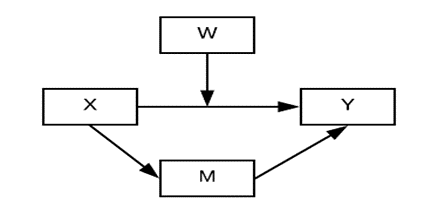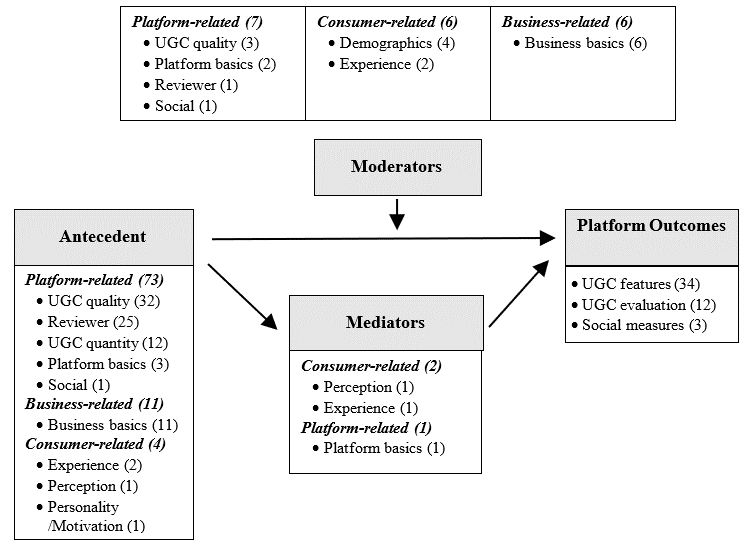INTRODUCTION
Social media have dramatically changed the way in which people communicate and interact with each other. Thus, the proliferation of social media usage requires new business models to challenge and replace traditional business processes and operations, especially in the business-to-consumer marketing context (Salo 2017). Businesses have increasingly adopted social media in their marketing strategies, including marketing intelligence, branding, promotions, public relations, customer management, marketing communications, and market research (Alves et al. 2016). Therefore, a good understanding of the mechanism and impact of social media will better prepare businesses to embrace new challenges and opportunities brought about by social media (Thomas 2007).
In response to the business needs of understanding social media, social media have become an emerging research topic in academia (Zeng and Gerritsen 2014). With the exponential increase of the number of social media-related publications, several literature review studies have been carried out to summarize the findings of various social media research and to systemize the prominent lines of research and knowledge body of social media applications in business (Alves et al. 2016;Salo 2017). In the hospitality and tourism fields, three literature review studies have identified major research themes/topics and outlined an overall picture of social media research (Leung et al. 2013;Leung et al. 2017;Zeng and Gerritsen 2014). However, the causal relationships within social media phenomena, which are the main interests of industry practitioners, have not been systematically investigated and summarized.
General business research classifies all research designs into three categories: exploratory, descriptive, and causal research (Zikmund et al. 2013). Among the three types of research, it is commonly acknowledged that causal research is more valuable to industry practitioners than descriptive research as it identifies the causes of outcomes (Lynn 2002). Therefore, a systematic review of causal research on the subject of social media will illustrate the inter-relationships among the relevant constructs and provide implications for the industry to leverage social media to generate the best possible outcomes.
Therefore, the purpose of the present study was to provide a systematic and structured review of published social media causal research in eight top hospitality and tourism journals from 2007 to 2017. Specifically, the current study set forth the following objectives: (1) to collect and display the theories and models adopted in recent social media research in hospitality and tourism; (2) to group the research constructs employed in current social media literature into antecedents, moderators, mediators, and outcomes; (3) to develop causal chain frameworks (Johnson and Christensen 2010) to illustrate causality among the research constructs; and (4) to suggest a research agenda for future research directions on social media. This study enhances the theoretical understanding of the existing social media research in hospitality and tourism by establishing causal chain frameworks. The findings also provide a research roadmap for academia, insights for the hospitality industry, and an agenda for future research.
1. LITERATURE REVIEW
1.1. Social media review studies in hospitality and tourism
In the last decade, the topic of social media has received increasing attention not only from the industry but also from academia (Ngai, Tao and Moon 2015). The number of publications on social media in hospitality and tourism has grown rapidly (Leung et al. 2017). Several review studies were conducted to reflect on its recent development.
For example,Leung et al. (2013) performed a content analysis to examine 44 social media research published between 2007 and 2011. The study classified the extant literature into two categories: consumer-related studies and supplier-related studies. Consumer-related studies were found to concentrate on investigating how consumers perceive, use, and process the information obtained from social media platforms during their trip planning phase. As for suppliers, social media had been proven to be an important strategic tool in hospitality and tourism marketing and management.Cantallops and Salvi (2014) reviewed social media-related publications from 2007 to 2011. Their study specifically examined published papers regarding the impact of electronic word-of-mouth (eWOM) on the hotel industry. Through content analysis, they investigated: (1) review-generating factors, such as service quality, customer satisfaction/dissatisfaction, social identity, and pre-purchase expectations; and (2) impacts of eWOM on both hospitality and tourism firms and their customers.
A timeline of social media research in tourism was summarized byZeng and Gerritsen (2014). Results indicated that social media research in the tourism field focused primarily on examining the initial impacts of social media on the tourism industry. After that, more social media studies investigated the use of social media in the field of tourism demands, tourism supply, and tourism destination marketing. Another recent social media review research byLu et al. (2018) identified four major topics of social media research in hospitality and tourism between 2004 and 2014: the role and effects of social media, behavior of social media users, social media content, and literature review. Unlike these previous studies,Leung et al. (2017) utilized a quantitative approach to offer a systematic overview of social media-related academic articles between 2007 and 2016. They identified Word-of-Mouth (WOM) as the major theoretical foundation of social media research in business journals and indicated that, social media research in the hospitality and tourism field showed a relatively diverse set of theoretical foundations, including online review, eWOM, information technology, and user-generated content (UGC).
1.2. Causal chain model
A causal chain model is an abstract model in which the researcher hypothesizes causal interrelationships and then empirically tests them (Johnson and Christensen 2010). The set of variables in a causal chain model are sequentially ordered based on time (Mertler and Reinhart 2016). Logically, an antecedent variable precedes and causes changes in the other variables, known as outcome variables (Mertler and Reinhart 2016). Unlike the previous causal frameworks (e.g., Purcell and Hutchinson 2007), the associations between antecedent variables and outcome variables in the causal chain model were not simply linear. Instead, it interpreted the outcome variables as the product of the influence of antecedents, mediators, and moderators (McCrae et al. 2017). Therefore, it was considered a more sophisticated causal model (McCrae et al. 2017).
In a causal chain framework, the causal relationship between any two linked variables is called the direct effect. As shown inFigure 1, the arrow X to Y indicates that the antecedent variable X is assumed to have a direct effect on the outcome variable Y. In addition to direct effects, a causal chain model hypothesizes indirect effects. An indirect effect occurs when the antecedent variable affects the outcome variable indirectly via a mediator, "the generative mechanism through which the focal independent variable is able to influence the dependent variable of interest" (Baron and Kenny 1986, 1173). InFigure 1, variable M acts as a mediator of the effect of X on Y. Furthermore, a causal chain model also includes a moderator function that “partitions a focal independent variable into subgroups that establish its domains of maximum effectiveness in regard to a given dependent variable” (Baron and Kenny 1986, 1173). InFigure 1, the variable W represents a moderator that affects the direction and/or strength of the relationship between X and Y.
The causal chain model has been creatively adapted by several review studies to summarize and visually present causal interrelationships in different topics.Ilgen et al. (2005) used an Input-Mediator-Outcome framework to summarize complex and dynamic causal interactions on team research in organizational contexts.Mohammed et al. (2010) adopted an antecedent-moderator-outcome model to conduct a 15-year literature review of the Team Mental Model. A recent study conducted byNgai et al. (2015) applied the full causal chain model to summarize 46 social media articles published between 2002 and 2011. This causal chain model concentrated on conceptualizing the relationships among antecedents, mediators, moderators, and outcomes. Similarly,Olanrewaju et al. (2020) employed a causal chain framework on social mediaand entrepreneurship research to identify relationships amongst elucidated constructs. Although these studies provided a useful method of presenting a pictorial summary of the current research body and the causal structure of a certain topic, this new method has not received enough attention to be utilized in other fields.
From social media review studies in hospitality and tourism research, it can be observed that most concentrated on identifying and listing thematic areas and prevailing topics (e.g., Leung et al. 2013;Lu et al. 2018). No research has undertaken the summarization and categorization of the theories and constructs adopted by existing social media studies in the context of hospitality and tourism. Additionally, the aforementioned review studies also lacked a conceptual framework to clearly explain the causal linkages between the research constructs. Therefore, inspired byNgai et al. (2015), this current study utilizes the causal chain model to conduct a comprehensive and structured literature review and to develop a research roadmap of the causal chain framework in social media research.
2. METHODOLOGY
2.1. Data collection
Similar toLeung et al.’s (2017) approach, the study selected empirical articles of social media-related research published in eight top hospitality and tourism journals. The eight journals are selected based onMcKercher, Law and Lam’s (2006) andGursoy and Sandstrom’s (2016) journal ranking studies, which are: Annals of Tourism Research, Cornell Hospitality Quarterly, International Journal of Contemporary Hospitality Management, International Journal of Hospitality Management, Journal of Hospitality and Tourism Research, Journal of Travel Research, Journal of Travel and Tourism Marketing, and Tourism Management.
Data collection of current study was conducted in 2018 and articles that were published in the eight journals between 2007 and 2017 were all taken into consideration. The titles and abstracts of all published articles were reviewed for relevancy to social media and those with no social media focus were eliminated. Only refereed papers were included in the present study, while any type of discussion notes, announcements, book reviews, conference/research comments, and editorial comments were excluded. In addition, this study focused on papers presenting causal research, so only studies with cause-effect relationship models were included. As a result, a total of 149 articles were selected for in-depth analysis.Table 1 shows the number of articles selected from each journal.
2.2. Data analysis
For each article, information collected included the title, publication year, publication journal, adopted theory, and constructs in the proposed model. The adopted theories were grouped based on their originating disciplines. The constructs were collected based on their positions in the proposed model, namely antecedent, outcome, mediator, and moderator (Ngai et al. 2015;Olanrewaju et al. 2020). In each position, the constructs were carefully reviewed, and similar constructs were combined. Then the refined constructs were grouped into categories and subcategories. The grouping process was based on existing literature and involved a comprehensive discussion between the researchers.
The collected data were analyzed in two steps. First, descriptive statistics were presented to show the status quo of theories and constructs employed in social media-related articles published in the eight hospitality and tourism journals. Second, three conceptual frameworks of social media research were proposed to display the causal relationships of different constructs based on an antecedent-moderator-mediator-outcome causal chain model (Ngai et al. 2015).
3. RESULTS
3.1. Adopted theories in social media research
Overall, a total of 74 different theories were adopted in recent social media research. Based on the originating discipline of the theory, the study identified five groups of theories: psychology theory, sociology theory, communication theory, marketing theory, and economic theory (Table 2).
As shown inTable 2, the most popular group of adopted theories in social media research originated from the psychology discipline, which explores and explains human behavior at the individual level. More than 40% of social media research articles used some psychology theories, resulting in a total of 29 different psychology theories. Some of the essential psychology theories were the dual process theory (also called the elaboration likelihood model) (6.7%- e.g., Hur et al. 2017), technology acceptance model (5.4%- e.g.,Casaló et al. 2010), trust theory (5.4%- e.g.,Lee and Hyun 2016), attribution theory (4.0%- e.g.,Bui et al. 2015), and theory of planned behavior (2.7%- e.g.,Casaló et al. 2010).
The second-largest group of adopted theories in social media research originated from the sociology discipline, which explores and explains the social behaviors of human beings. A large portion of social media-related publications (23.5%) used some sociology theories and 16 different sociology theories were found to have been adopted (Table 2). Among them, the most significant sociology theories included the social identity theory (6.7%- e.g.,Casaló et al., 2010), social exchange theory (2.7%- e.g.,Kang et al. 2014), social influence theory (2.0%- e.g.,Book et al. 2016), and homophily theory (2.0%- e.g.,Ayeh et al. 2013).
The third group of adopted theories, originated from the marketing discipline, explores and explains consumer behaviors. As hospitality and tourism businesses often use social media in their marketing efforts, the study found that quite a few social media-related studies (16.1%) used a total of 10 different marketing theories. Some of the leading marketing theories included the expectancy disconfirmation theory (4.7%- e.g.,Brochado et al. 2015), commitment-trust theory of relationship marketing (2.7%- e.g.,Li and Chang 2016), means-end theory (2.0%- e.g.,Book et al. 2016), and attitude toward the ad model (2.0%- e.g.,Leung et al. 2015).
The fourth group of adopted theories in social media research originated from the communication discipline, which explains media-relation phenomena and explains how humans process information. Thirteen different communication theories were identified in many social media-related studies (16.1%). Among them, several prominent communication theories were the uses and gratifications theory (2.7%- e.g.,Hur et al. 2017), two-step flow of communication theory (2.0%-e.g., Jeong and Jang 2011), and source credibility theory (2.0%- e.g.,Ayeh et al. 2013).
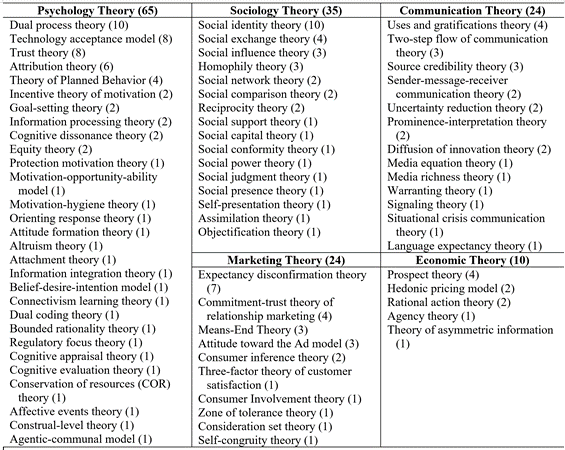
Note: Numbers in parentheses represent frequency.
The last group of adopted theories in social media research originated from the economic discipline, which explains economic phenomena. In social media research, economic theories were heavily used in understanding hospitality and tourism business performance, especially pricing. Only a limited number of social media-related studies (6.7%) adopted five different economic theories, including the prospect theory (2.7%- e.g.,Park and Nicolau 2015), hedonic pricing model (1.3%- e.g.,Schamel 2012), and rational action theory (1.3%- e.g.,Xie et al. 2016).
3.2. Constructs used in social media research
Based on the causal chain model, the research constructs used in the selected publications were grouped according to their respective positions in the model (McCrae et al. 2017;Ngai et al. 2015). Four groups of constructs were identified: antecedents, mediators, moderators, and outcomes. In brief, antecedents are input/independent variables that lead to outcomes; mediators explain the causalities between antecedents and outcomes, while moderators impact the direction and/or strength of the causalities (Baron and Kenny 1986). Similar toNgai et al.’s (2015) findings, the present study also reveals many construct cross-overs in different groups. That is, the same constructs are shown in different positions in the model of different articles due to specific research purposes.
3.2.1. Antecedents
In sum, a total of 88 different antecedents were identified in the selected social media publications. As shown inTable 3, the antecedents used in social media research were grouped into three categories and 12 sub-categories. The three categories were platform-related, consumer-related, and business-related.
As shown inTable 3, the most prevalent category of antecedents in social media research was platform-related, which includes features of social media platforms and user-generated content (UGC) on social media. A plethora of social media studies used more than one antecedent in this category, resulting in a total of more than 100% (131.5%). In sum, 36 different platform-related antecedents were applied in current social media research in hospitality and tourism, forming five sub-categories. Among them, three sub-categories represented UGC-related measures (UGC quality, UGC quantity, and reviewer measures) while two sub-categories reflected platform-general measures (platform basics and social measures). The most widely used sub-category, UGC quality measures (45.6%), contained factors that describe the content of UGC, while the UGC quantity measures sub-category (36.2%) captured the number-related features of UGC. The last UGC-related sub-category, reviewer measures (22.8%), included factors related to reviewers or those who create UGC on social media. The Platform basics sub-category (18.1%) contained factors that generally describe the characteristics of social media platforms and the other platform-related sub-category, social measures (8.7%), specified the social elements of social media platforms. The findings indicate that although social media involves numerous social factors, the application of social factors as antecedents in current social media research is limited.
The second popular category of antecedents in social media research was consumer-related, which reflects the attitudinal, behavioral, and innate characteristics of social media users. Thirty-four different consumer-related antecedents were identified in 63.8% of selected social media publications, forming four sub-categories. The most widely used sub-category, perception measures (26.2%), contained factors that measure consumers’ perceived feelings or impressions. Another popular consumer-related antecedent sub-category, experience measures (19.5%), was related to consumers’ usage and involvement in social media or the internet. The personality/motivation measures sub-category (10.7%) described social media users’ unique personality or motivation and the last sub-category, demographic measures (7.4%), contained different demographic factors of social media users.
The last category of antecedents in social media research was business-related, which explores hospitality and tourism businesses’ basic and managerial characteristics. About one-third of selected social media articles (34.1%) used some antecedents from this category, resulting in a total of 18 different consumer-related antecedents. Three sub-categories were identified in this category. The leading sub-category, business basics (22.1%), captured basic features of hospitality and tourism businesses and their products. The performance measures sub-category (6.7%) described the performance or outcomes of business operation. The last sub-category, advertising measures (5.4%), contained factors related to business advertising or marketing.
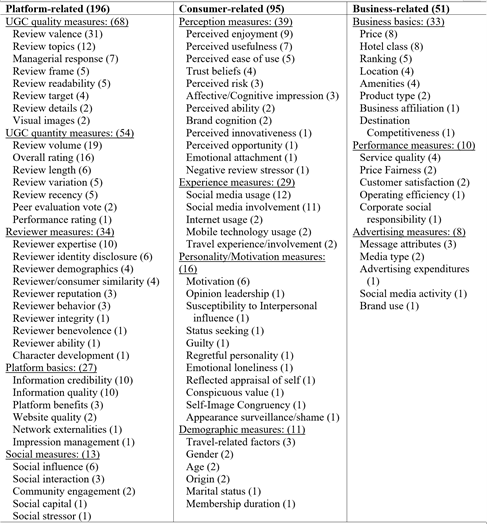
Note: Numbers in parentheses represent frequency.
3.2.2. Outcomes
In sum, 48 different antecedents were identified in the selected social media publications. As the antecedents, the outcomes used in social media research were also grouped into three categories: consumer outcomes, business outcomes, and platform outcomes (Table 4).
As shown inTable 4, unlike the antecedents, the most popular category of outcomes in social media research was consumer outcomes, referring to the changes in consumers’ attitudes, intentions, and/or behaviors resulting from social media usage and influence. A total of 12 different consumer outcomes were identified in the selected social media articles, forming three sub-categories. First, 42.3% of selected social media publications investigated consumers’ intentions, including purchase intention of business products/services (21.5%); intention of information or experience sharing (eWOM, 12.1%); and intention of social media usage, UGC adoption, and information search (8.7%). The second sub-category, psychological influence, was explored in 14.8% of social media articles, mainly focusing on consumers’ attitudes (6.7%) and satisfaction (6.0%). Additionally, 13.4% of social media research articles focused on actual consumer behaviors, including social media usage (UGC adoption and information search, 5.4%), eWOM and information sharing behavior (4.7%), and consumer experience (2.0%).
The second most common category of outcomes in social media research was business outcomes, which examine hospitality and tourism business operation and performance-related outcomes. Four sub-categories were formed with a total of 22 different business outcomes. Many more studies were exploring evaluation (20.1%) and performance (14.1%) of business outcomes than HR (2.0%) and advertising outcomes (1.3%). The evaluation sub-category measures business performances from either the consumers’ or owners’ perspective, including service quality (4.0%), trust (4.0%), business loyalty (2.7%), brand commitment (2.7%), business value (2.0%), and product expectation (2.0%). On the other hand, the performance sub-category examines business performances using objective indicators or measures. For example, the use of key performance indicators (7.4%), including occupancy, ADR, RevPar, TrevPAR, net sales, guest counts, and average check, was one of the prevailing outcomes in this sub-category. Product or service price (2.7%) was another example of a performance outcome. The other two sub-categories of business outcomes investigated the operation processes of hospitality and tourism businesses, including human resource management (HR) and advertising.
The last category of outcomes in social media research was platform outcomes, which explore various features and perceptions of UGC on social media platforms. There were 14 different platform outcomes forming three sub-categories. As the biggest sub-category, 22.8% of social media research studied the objective features of UGC, including overall rating (10.1%), peer evaluation vote (8.1%), review content (2.0%), and review volume (1.3%). A small percentage of social media research (8.1%) investigated subjective perceptions of UGC, such as information quality (2.7%), information credibility (1.3%), and UGC helpfulness (1.3%). Compared to the other two sub-categories, the last sub-category, social measures, only received very limited research attention (2.0%).

Note: Numbers in parentheses represent frequency.
3.2.3. Moderators
While all research models require antecedents and outcomes, not all of them use moderators or mediators. Our results reveal that about half of selected social media publications used moderators (55.7%) or mediators (49.7%) in their research model building. As shown inTable 5, a total of 47 different moderators were identified and grouped into the same three categories as platform-related, consumer-related, and business-related.
As shown inTable 5, unlike the antecedents and the outcomes, the three categories of moderators were employed almost equally in social media research. The platform-related and consumer-related moderators were both used in 19.5% of the selected social media publications, while business-related moderators were used in 16.8% of the sample. In total, there were 19 different consumer-related moderators, 16 different platform-related, and 12 business-related.

Note: Numbers in parentheses represent frequency.
Among platform-related moderators, the same five sub-categories were identified as with the platform-related antecedents: UGC quality, UGC quantity, reviewer measures, platform basics, and social measures. The majority of the platform-related moderators also appeared as antecedents in other studies. Only a few new moderators were employed, including emotional expression (e.g.,Lee et al. 2017) and platform awareness (e.g.,Casaló et al. 2015).
Four subcategories were identified in consumer-related moderators, namely demographic measures, experience measures, personality measures, and perception measures. While most of the consumer-related moderators were also used as antecedents in different studies, demographic measures played a heavier role as moderators, while perception measures were used more frequently as antecedents. A few new consumer-related moderator factors were identified, such as body mass index (e.g.,Lyu 2016), brand familiarity (e.g.,Tan and Chang 2016), and sense of power (e.g.,Choi et al. 2017).
Three sub-categories were identified in business-related moderators, including business basics, advertising measures, and HR measures. HR measures was a new sub-category of business-related moderators, containing factors related to business human resource management, such as employee selection purpose (e.g.,Madera 2012). A few new moderators also appeared in the other two sub-categories, such as persuasion route (e.g.,Cheng and Loi 2014) and sales promotion (e.g.,Kang et al. 2015).
3.2.4. Mediators
Forty-one different mediators were identified in the selected social media articles. As shown inTable 6, the mediators used in social media research were also grouped into the three categories of platform-related, consumer-related, and business-related.

Note: Numbers in parentheses represent frequency.
As shown inTable 6, unlike antecedents, the most popular category of mediators in social media research was consumer-related. A total of 23 different consumer-related mediators were identified in 28.2% of the selected social media publications, forming four sub-categories, including attitude/motivation measures (11.4%), perception measures (8.7%), experience measures (6.7%), and intention measures (1.3%). Both mediators and antecedents had the same two sub-categories, perception measures and experience measures. Many of the same factors that served as antecedents in some studies acted as mediators in others, such as perceived usefulness, perceived ease of use, and social media usage. However, there were also new factors that appeared in mediators, including switching cost (e.g.,Li and Chang 2016) and satisfaction or dissatisfaction (e.g.,Bui et al. 2015). In addition, attitude and intention became new sub-categories in mediators and encompassed attitude toward business (e.g.,Casaló et al. 2010), ad attitude (e.g.,Leung et al. 2015), and intention of social media usage (e.g.,Tan and Chang 2016).
The second most commonly used category of mediator in social media research was platform-related. There were 13 different platform-related mediators used in 15.4% of the selected social media articles. Four sub-categories were identified: platform basics, social measures, UGC measures, and reviewer measures. Compared to platform-related antecedents, there were far fewer mediators in the UGC or reviewer sub-categories. Most of the platform-related mediators were used as antecedents in other studies. However, some mediators also appeared, like platform commitment (e.g.,Bui et al. 2015), social presence (e.g.,Kang and Gretzel 2012), language typicality (e.g., Wu et al. 2017), and reviewer attractiveness (e.g.,Ert et al. 2016).
The last category of mediator, business-related, contained five different mediators that form three sub-categories. About 6% of selected social media publications used business-related mediators. The three sub-categories are evaluation measures, performance measures, and HR measures. Compared with business-related antecedents, both evaluation measures and HR measures were unique to business-related mediators, including brand trust (e.g.,Lee and Hyun 2016), business loyalty (e.g.,Bui et al. 2015), and employee anger (e.g.,Weber et al. 2017).
3.3. Causal chain frameworks of social media research
The study then conceptualized casual chain frameworks to express the interrelationships of different constructs in social media research. The frameworks were built as input-moderator-mediator-output models based upon the four groups of constructs (McCrae et al. 2017;Ngai et al. 2015). Due to the large number of constructs involved in the selected social media publications, the study developed three casual chain frameworks using the three categories of outcomes. In sum, there were 74 publications investigating consumer outcomes, 50 exploring business outcomes, and 39 examining platform outcomes. About half of the models adopted moderators. Research on consumer outcomes employed the greatest number of mediators (0.76), while studies on platform outcomes hardly utilized any mediators (0.08).
Figure 2 displays the first causal chain framework of consumer outcomes in social media research. Consumer-related and platform-related constructs were commonly used as causes of consumer outcomes, both as antecedents (100.0% and 95.9%, respectively) and moderators (24.3% and 18.9%, respectively). Perception (41.9%), UGC quality (31.1%), experience (27.0%), and platform basics (27.0%) were the most popular sub-categories of antecedents that caused consumer outcomes, while personality (9.5%) and demographics (6.8%) were the two most common sub-categories of moderators. Consumer-related mediators (48.6%) heavily affected causalities between antecedents and consumer outcomes. In particular, attitude/motivation (23.04%), perception (14.9%), and platform basics (10.8%) were the three most widely used sub-categories of mediators. Comparatively speaking, business-related constructs were less adopted in the causal chain framework of consumer outcomes.
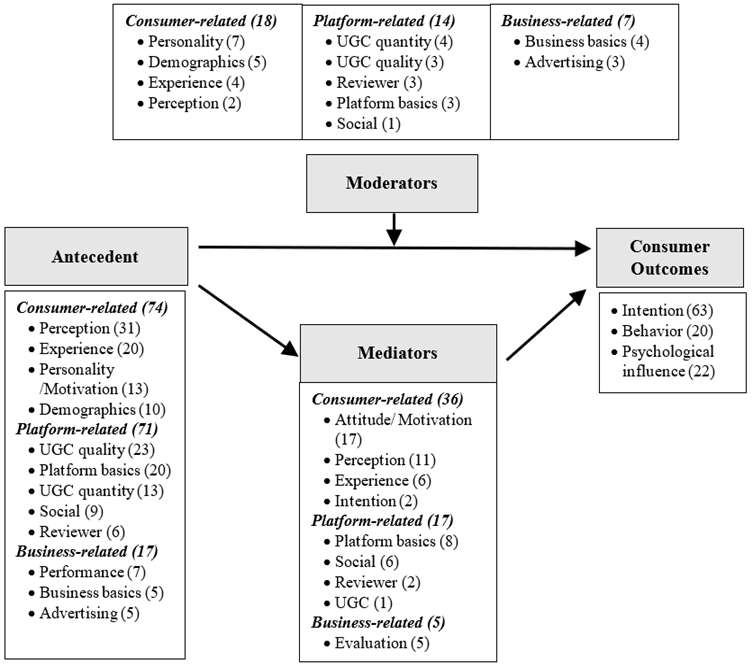
Figure 3 shows the causal chain framework of business outcomes in social media research. Platform-related antecedents (142.0%) were heavily adopted in predicting business outcomes, while both business-related (28.0%) and platform-related constructs (26.0%) were commonly used as moderators. UGC quantity, UGC quality, and business basics were the most popular sub-categories of antecedents (64.0%, 50.0%, and 40.0%, respectively) and moderators (12.0%, 10.0%, and 22.0%, respectively). Research on business outcomes did not seem to use mediators as often as those on consumer outcomes. The three categories of mediators, platform-related (14.0%), consumer-related (12.0%), and business-related (10.0%), were all infrequently involved.
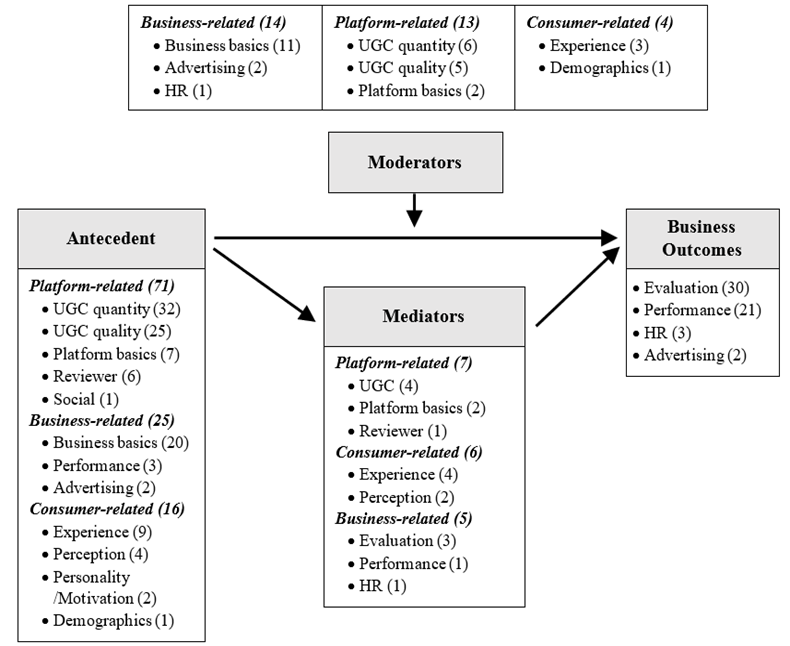
Figure 4 presents the last causal chain framework of platform outcomes in social media research. As with business outcomes, platform-related antecedents (187.2%) were the most prevalent in predicting platform outcomes. UGC quality (82.1%) and reviewer (64.1%) were the most popular sub-categories of antecedents. Relatively speaking, platform outcome models adopted fewer moderators but used all the three categories evenly: platform-related (17.9%), consumer-related (15.4%), and business-related (15.4%).
In summary, platform-related antecedents were adopted widely to explain various outcomes in social media research in hospitality and tourism. Compared to the vast number of antecedents used, the adoption of moderators and mediators in social media research was still limited. Compared to studies on the other two outcomes, studies on platform outcomes hardly used any mediators.
4. Discussion and Conclusion
The present study reviewed social media-related causal research published in eight hospitality and tourism journals from 2007 to 2017 to understand how previous studies applied theories and developed their models to conduct social media-related research in the hospitality and tourism field. The variables adopted in the sample articles were categorized into four groups based on their roles in the research models: antecedents, mediators, moderators, and outcomes. The variables in each group were then classified into three categories: consumer-related, business-related, and platform-related. The study then developed three causal chain frameworks of social media research in hospitality and tourism to reveal the inter-relationships among research constructs.
The study reveals many meaningful findings which help to identify future research directions. First of all, social media-related research borrowed theories mainly from the psychology discipline to explain social media users’ behaviors (Table 2). In terms of specific theories, the dual process theory (including the elaboration likelihood model), social identity theory, technology acceptance model, trust theory, and expectancy disconfirmation theory have been used the most in social media research. While this finding is partially consistent withNgai et al. (2015), which identified the technology acceptance model and social identity theory as popular theories, this study further reveals new essential theories in social media research (e.g., dual process theory, trust theory, expectancy disconfirmation theory). Based on the findings, social media research has expanded from merely explaining social behavior and acceptance of new technology to exploring users’ general information processing, satisfaction forming, and trust-building. In the future research, although psychology theories may continue to provide the theoretical frameworks for social media research, additional research efforts are needed to explore this phenomenon from marketing or economic theoretical foundations in order to provide more business performance-related insights (Salo 2017;Olanrewaju et al. 2020). More interdisciplinary research efforts are strongly encouraged.
Second, as unique features of social media platforms, platform-related antecedents were identified as the most prevalent antecedents in social media research, especially characteristics of UGC such as review valence, review topics, review volume, and overall ratings; characteristics of reviewers such as reviewer expertise; and general platform characteristics such as information credibility and quality. Compared toNgai et al.’s (2015) findings, this study reveals significant progress in incorporating platform attributes into social media causal research. Social media-related experience factors have also been adopted widely in consumer-related the antecedent category. Perceived enjoyment, perceived usefulness, and perceived ease of use have also received greater attention due to the heavy usage of the technology acceptance model as a theoretical framework. Relatively speaking, business-related factors were less commonly used as antecedents (Table 3). Therefore, future research should explore how business-related antecedents will influence outcomes. For example, most existing research focuses on property level antecedents such as hotel class, ranking, location, and amenities. In addition, given the nature of hospitality and tourism businesses, it is suggested that business-related antecedents be examined from the various levels to include not just the property level but also the brand and company/corporate levels. This approach will compare business-related antecedents as independent variables at three levels of analysis (property level, brand level, and corporate level). The study results indicate that businesses’ past performance measures can also be considered for future performance forecasting and trending. For example, as shown inTable 4, the measures for business outcomes such as key performance indicators, market share, conversion rate, and transaction value are good candidates for such econometric model building. Moreover, cultural differences related to the adoption of business-related antecedents should also be considered (Lim 1995). When it comes to social media, research efforts are needed to understand how such corporate culture affects social media usage by all members of the organization.
Third, consumer outcomes have received the most research interest, with more than half of the selected publications investigating consumer outcomes (Table 4). Unlike the prevalent usage of platform-related factors as antecedents, there was the least amount of research exploring platform outcomes. For consumer outcomes, however, more research focused on explaining intentions than exploring actual behaviors. For business outcomes, most research was dedicated to explaining actual performance and evaluation of performance, while very few studies investigated the business operation processes such as advertising or HR. For platform outcomes, the majority of research focused on UGC-related features while general platform features were largely ignored. This finding corroboratesSalo’s (2017) assertation that current social media marketing research focuses on social media’s tactical use rather than a more strategic use. Future research should help hospitality businesses understand how social media platforms will drive traffic and generate economic gains (Alves et al. 2016). We anticipate that future studies will employ more economic theories to explore social media platforms’ economic impacts on hospitality and tourism businesses. For example, cost and benefit analyses should be conducted to examine potential economic gains through managing social media platforms. In addition to financial business outcomes, non-financial issues related to human resources such as employee engagement deserve future research attention. For instance, much research has been done from the perspective of customer engagement and behaviors. Studies on how employees perceive their employers through posts and interactions with various stakeholders may influence and retain employees.
Fourth, only about half of the selected social media publications have used moderators or mediators in their research model building. UnlikeNgai et al.’s (2015) findings, the present study found that the three categories of moderators were evenly applied in social media research. Some popular moderators in each category include UGC features such as managerial response and overall rating, consumers’ experience, and business-related hotel class. In terms of mediators, although the study confirmsNgai et al. (2015)’s findings that consumer-related variables are the most commonly used mediators in social media research, the study also indicates that users’ attitude, not users’ behavior, was adopted as the top consumer-related mediator. However, such usage is somewhat limited, especially when exploring platform outcomes, as mediators are hardly included. Business-related variables were rarely included as mediators in research models. Future research should use more moderators and mediators in the construction of research models. It is promising and essential to investigate the effect of moderators and mediators on the relationship between variables -- mostly independent and dependent variables. This exploration will contribute to the refinement of hypothesis development and provide practical implications to industry professionals. The study calls for future researchers’ attention to incorporate some innovative moderators and mediators identified in this study, such as emotional expression (e.g.,Lee et al. 2017), sense of power (e.g.,Choi et al. 2017), persuasion route (e.g.,Cheng and Loi 2014), switching cost (e.g.,Li and Chang 2016), platform commitment (e.g.,Bui et al. 2015), language typicality (e.g.,Wu et al. 2017), and employee anger (e.g.,Weber et al. 2017).
Finally, this review study explores three causal chain frameworks of consumer outcomes, business outcomes, and platform outcomes. But the findings indicate a lack of cross-category causal relationships, such as using consumer-related antecedents and moderators to predict business outcomes or vice versa. Therefore, we urge scholars to integrate knowledge across the three causal chain frameworks summarized in this study to address crucial social media research questions, as suggested byOlanrewaju et al. (2020). Built upon the findings of this study, future research may think beyond the box of what has been studied in their own category. For example, future research can explore consumer-related antecedents, moderators, and mediators to predict business outcomes. How to combine business-related and consumer-related antecedents and moderators to influence platform outcomes is also worthy of investigation. Driven by theory, such cross-category approaches will help to identify pertinent research issues and lead to compressive research designs, thus generating insightful results.
This present study contributes to the hospitality and tourism literature by applying casual chain models to systematically review social media research in the hospitality and tourism field. The findings of the study have created a research roadmap in social media that enables readers to easily understand the research body and underlying causal structure of this field. The study also revealed the theories and constructs applied in current social media research, which can be used as an immediate reference for future research in this subject area. What’s more, this methodology to conduct a literature review can be applied in the future for literature review on other topics.
While the present study has its merits, certain limitations remain. The literature review may not be exhaustive, mainly because this study only collected research articles from the eight hospitality and tourism journals between 2007 and 2017. Recently, more journals have published social media-related research articles in hospitality and tourism. More work is required in future studies to include papers from different sources, such as other hospitality and tourism journals, and to include more recent publications. Moreover, the categorization of research constructs developed in this study was new and novel. Future research could be carried out to further improve this categorization. Also, this study did not provide any statistical analysis of causal relations as in a meta-analysis review. Future studies could select one outcome variable, such as purchase intention or intention of eWOM, and use meta-analysis to conduct a literature review for statistical insights. In addition, since social media research is still in its early stage, continued efforts in reviewing the current body of research should be encouraged to assess the status quo and provide directions for future research. Finally, the new causal chain conceptual model method used in the present study should be employed in the future for literature reviews on other topics in hospitality and tourism research.

